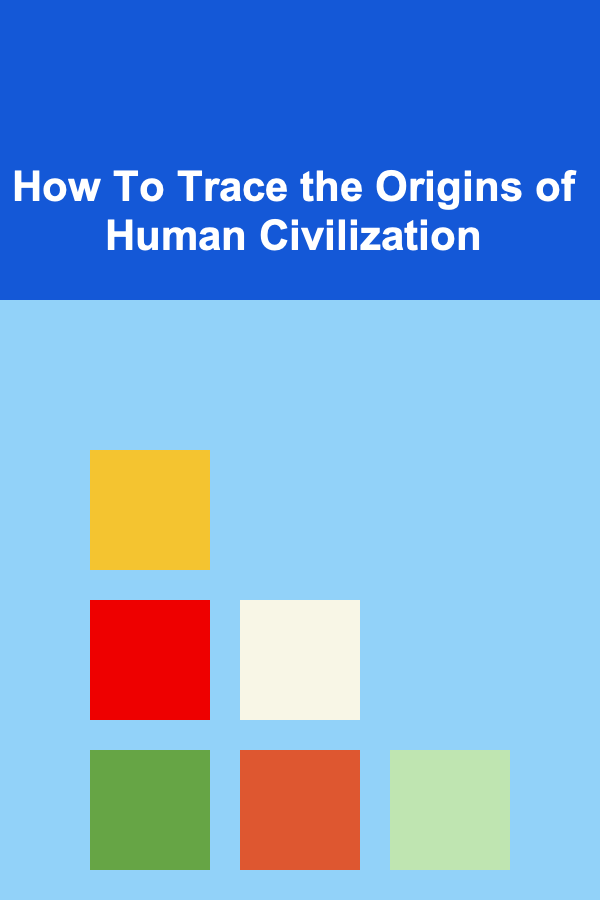
How To Trace the Origins of Human Civilization
ebook include PDF & Audio bundle (Micro Guide)
$12.99$9.99
Limited Time Offer! Order within the next:

Tracing the origins of human civilization is one of the most fascinating and complex endeavors undertaken by historians, archaeologists, anthropologists, and scholars across various disciplines. Understanding the birth and evolution of human society not only illuminates our past but also sheds light on the path humanity has taken to become the advanced, interconnected world we know today.
The origins of human civilization lie in a long process that spans hundreds of thousands of years, evolving from nomadic hunter-gatherers into complex societies with distinct languages, cultures, technologies, and social structures. To trace these origins effectively, one must delve into multiple aspects of human history, including early human evolution, the advent of agriculture, the rise of ancient civilizations, and the development of written languages, systems of governance, and cultural practices.
The Dawn of Humanity: From Prehistoric to Pre-civilized Societies
Evolution of Homo Sapiens
The story of human civilization begins with the evolution of Homo sapiens from earlier hominids, including species such as Homo habilis and Homo erectus. This evolution, which spans millions of years, can be traced using fossil evidence, genetic data, and archaeological discoveries. Homo sapiens, the species that eventually gave rise to modern humans, emerged around 200,000 to 300,000 years ago in Africa.
Early Homo sapiens were hunter-gatherers, relying on their skills in tool-making, hunting, and foraging for survival. They lived in small, mobile groups, and their societies were largely egalitarian, with social hierarchies based on age, skill, or kinship rather than formal structures.
Early Homo Sapiens and the Development of Tools and Culture
The cognitive revolution, believed to have occurred around 70,000 years ago, played a pivotal role in the development of human civilization. Early Homo sapiens demonstrated advanced tool-making techniques, symbolic art, and the ability to communicate through complex language. Evidence of this can be found in cave paintings, burial rituals, and intricate stone tools discovered at various archaeological sites.
This cultural shift allowed early humans to adapt to diverse environments, cooperate more effectively in groups, and create shared myths, stories, and rituals. It was also during this time that humans began to develop social structures, including family groups and clans, which would eventually form the foundation of more complex societies.
The Agricultural Revolution: The Birth of Civilization
The Shift from Nomadic to Settled Life
One of the most significant turning points in the origins of human civilization was the Agricultural Revolution, which began around 10,000 years ago. This was the period during which humans transitioned from a nomadic, hunter-gatherer lifestyle to settled farming communities. The development of agriculture allowed human populations to grow and settle in one place, leading to the formation of villages and eventually cities.
The agricultural revolution occurred independently in various parts of the world, including the Fertile Crescent in the Middle East, the Indus Valley in South Asia, and Mesoamerica in the Americas. Early agricultural practices involved the domestication of plants and animals, such as wheat, barley, rice, and cattle, which provided a stable food source and allowed communities to support larger populations.
The Rise of Surplus and Specialization
As humans began to produce surplus food through farming, the need for labor specialization became apparent. This surplus allowed for the development of new occupations, including artisans, traders, and religious leaders. It also led to the establishment of trade routes, as people began to exchange goods and services. These early agricultural societies began to develop new technologies, including pottery, weaving, and metallurgy, which helped shape the material culture of early civilizations.
The agricultural revolution also had significant social and political implications. As food surpluses increased, communities became more stratified, with elite classes emerging to control the distribution of resources. These early elites often took the form of chiefs, priests, or kings, who wielded power over the population. This marked the beginning of more hierarchical and organized forms of governance.
The Birth of Early Civilizations
The Rise of Urban Centers
The growth of agriculture led to the formation of the first cities, which were the precursors to early civilizations. The earliest urban centers arose in the Near East, particularly in the region known as the Fertile Crescent, which includes modern-day Iraq, Syria, and Turkey. One of the earliest known cities was Uruk, located in ancient Mesopotamia, which had a population of tens of thousands by 3000 BCE.
These early cities were marked by impressive architectural structures, including temples, palaces, and defensive walls. They were also centers of commerce, religion, and administration. The development of writing systems, such as cuneiform in Mesopotamia, and the establishment of legal codes, such as the Code of Hammurabi, further marked the sophistication of these early civilizations.
The Rise of Writing and Record-Keeping
The invention of writing is perhaps the most defining characteristic of civilization. Writing allowed societies to keep records, communicate across distances, and preserve cultural knowledge for future generations. In Mesopotamia, the Sumerians developed one of the earliest forms of writing, known as cuneiform, around 3000 BCE. Cuneiform was initially used for administrative purposes, such as recording trade transactions and inventory, but it eventually expanded to include literature, law, and history.
Similarly, the ancient Egyptians developed hieroglyphic writing around the same time, which was used primarily for religious and royal purposes. These early writing systems were crucial in the development of organized societies, as they allowed rulers to codify laws, collect taxes, and manage resources more effectively.
The Rise of Religion and Ideology
Religion played a central role in the formation of early civilizations. In ancient Mesopotamia, the Sumerians built massive temples to honor their gods, and religion was deeply intertwined with politics and governance. Kings were often seen as divine figures or as representatives of the gods, and they used religion to legitimize their authority.
In Egypt, the pharaohs were believed to be gods themselves, and their rule was justified through religious doctrine. Temples were central to Egyptian society, and much of the art and architecture from this period reflects religious beliefs.
Religious ideologies helped maintain social order and cohesion, as they provided a common set of beliefs and practices that united people across diverse regions. This shared religious worldview also fostered the growth of monumental architecture, including the construction of the ziggurats of Mesopotamia and the pyramids of Egypt.
The Development of Political Systems
Early Forms of Governance
As early civilizations became more complex, so too did their political structures. The first forms of centralized governance were established in ancient Sumer, Egypt, the Indus Valley, and China. These early states were typically led by powerful rulers who exercised control over vast territories and populations.
In Mesopotamia, city-states such as Ur and Babylon were ruled by kings, who often claimed divine right to govern. Similarly, in ancient Egypt, the pharaohs were absolute rulers who governed with the help of a bureaucratic system. In China, the first dynasties, such as the Shang and Zhou, established centralized control over large territories through military conquest and political alliances.
The Concept of Law and Justice
The development of law was another hallmark of early civilization. The Code of Hammurabi, created in ancient Babylon around 1754 BCE, is one of the earliest known legal codes. It established a system of laws that governed everything from property rights to criminal justice, with punishments for offenses ranging from theft to murder.
In ancient Greece and Rome, the concept of law evolved further, with the Greeks developing early democratic systems and the Romans codifying laws into comprehensive legal systems that would influence Western legal traditions for centuries.
Conclusion
Tracing the origins of human civilization involves understanding a complex web of evolutionary, social, political, and technological developments that span millennia. From the emergence of Homo sapiens and the cognitive revolution to the rise of agriculture, urbanization, writing, and governance, the origins of human civilization are deeply rooted in our ability to adapt, innovate, and cooperate.
As we continue to explore and uncover the history of human civilization, it is essential to recognize that our modern world is built on the foundations laid by ancient societies. Understanding where we come from not only helps us appreciate the progress humanity has made but also provides valuable insights into the challenges and opportunities we face as a global society today.

How to Avoid Common Customs Issues When Shipping Products Internationally in Dropshipping
Read More
How to Keep Kids Organized During Family Vacations
Read More
How to Make a Checklist for Managing Accessibility Updates on Your Website
Read More
How to Set Up an E-commerce Website: A Step-by-Step Checklist
Read More
How to Use Baskets for Organizing Hair Accessories
Read More
The Art of Web Content Management: Strategies for Crafting Compelling and Effective Websites
Read MoreOther Products

How to Avoid Common Customs Issues When Shipping Products Internationally in Dropshipping
Read More
How to Keep Kids Organized During Family Vacations
Read More
How to Make a Checklist for Managing Accessibility Updates on Your Website
Read More
How to Set Up an E-commerce Website: A Step-by-Step Checklist
Read More
How to Use Baskets for Organizing Hair Accessories
Read More